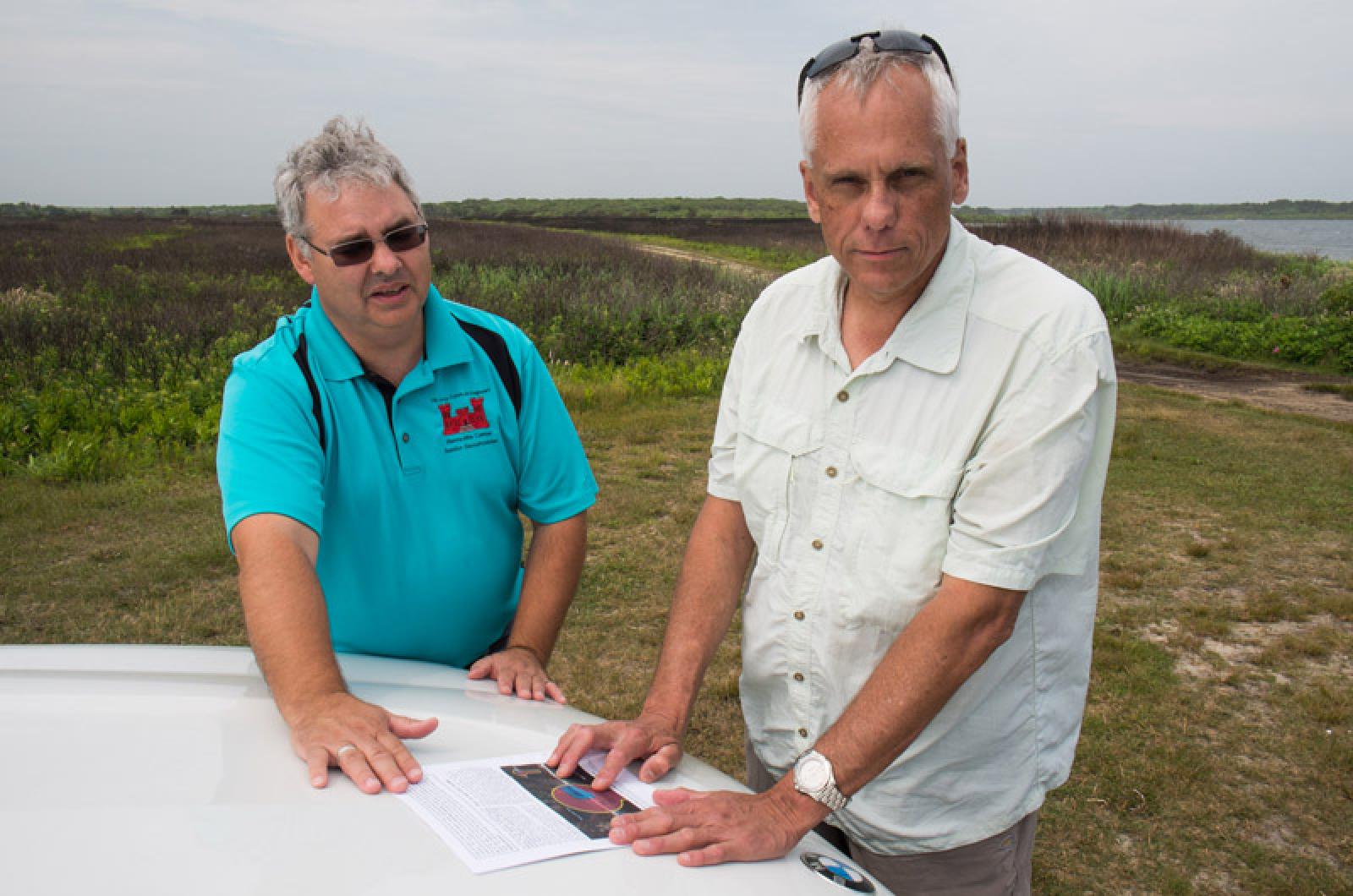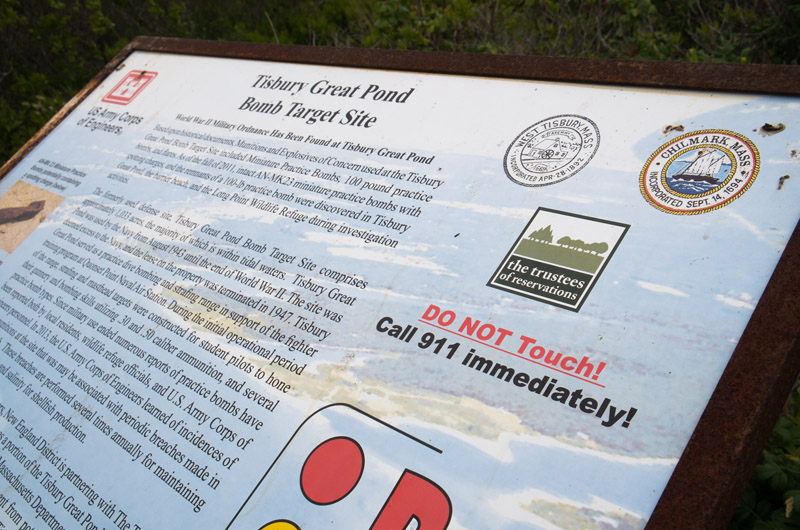The Army Corps of Engineers has recommended a $9.8 million project to remove practice bombs and other debris from a former World War II bombing range along the south shore in West Tisbury. A five-year investigation and feasibility study was completed this month, setting the stage for the next phase of the project, which may involve remediating the barrier beach at Tisbury Great Pond.
Army Corps workers began surveying the area in 2009, covering about 1,000 acres and identifying six hazardous munitions and 31 pieces of non-hazardous debris. The team has also surveyed a much larger area along South Beach and Norton Point in Edgartown, and two smaller areas on Cape Pogue. Remediation work at Cape Pogue will likely begin this year.
In Edgartown, a survey of about 4,400 acres, mostly in the ocean, turned up 98 pieces of munitions debris. A previous removal effort had unearthed two 100-pound bombs at Wasque Point, 617 pieces of munitions debris, and 99 inert rockets. The Army Corps has recommended a $621,000 public education program to reduce the risk of injury at the site.
Project managers, researchers, contractors and others involved in the projects attended public hearings in West Tisbury and Edgartown on Tuesday and Wednesday. A public comment period opened last Monday and will close July 17.
About 10 members of the public attended the West Tisbury hearing, at which Army Corps project manager Carol Charette outlined the four management options that were considered. The options range from taking no action to clearing the entire 123 acres of all munitions and debris and using signs, brochures and other methods to educate the public. Other alternatives included clearing only the land areas, which would be less expensive, and relying on education only.
Formerly used defense sites (FUDS) around the country serve as a reminder of the widespread mobilization that took place before and after the U.S. entered World War II in 1941. The three FUDS sites on the Vineyard operated between around 1943 and 1947 and covered nearly 6,000 acres.
The Vineyard sites served mainly as aerial bombing targets, and are littered with three and 100-pound practice bombs that often contained a small black-powder charge. Many bombs also contained plaster, water or sand so pilots could see where they landed.
Ralph Campbell, chief of ordnance and explosives at the Huntsville center, who also led the surveys, said the charges contained about as much black powder as a shotgun shell. “Black powder does not have a shelf life,” he said, adding that even some Civil War munitions are still dangerous.
Ms. Charette said she was unaware of anyone on the Island being injured by a practice bomb. But she also stressed the importance of removing hazardous materials. “There is a liability associated with this,” she said.
The survey identified 123 acres in West Tisbury and 695 acres in Edgartown for further study. Surveyors will use high-sensitivity metal detectors and GPS to pinpoint munitions items.
Erosion has been a significant factor at both sites, where munitions and debris have been washed out through openings in the barrier beaches and carried east by the currents. Most of the items were found east of where the bombing targets are thought to have been. The targets themselves now lie well offshore as a result of the eroding shoreline.
Researchers believe that munitions at the West Tisbury site have been buried too far below the dunes for detection at the surface. So fully clearing the site would mean removing sand from the dunes. That would also require working with state and local agencies to minimize ecological impacts, including to nesting shorebirds and the endangered northeastern beach tiger beetle. The Army Corps would reestablish the dunes and their native vegetation. The cost of the full cleanup is estimated at $9.86 million.
But some residents on Tuesday were skeptical of the process.
“It seems somewhat implausible,” said Keston Smith of the plan to complete the work by the following year. Woollcott Smith suggested a trial run to see if the methods would be effective.
Felicity Russell asked simply if the project could be stopped. Attorney Walter Roberts of the Huntsville center said the Army Corps could always choose the no-action alternative. “Public comments change our preferred alternative all the time,” he said. “Usually we are looking for evidence, other information we don’t know about, in order to make that decision.”
Ms. Charette pointed out that the Army Corps is known for establishing wetlands and grasslands, and that the restored dunes would be monitored to make sure the plants take hold. “If they die we are going to replant,” she said. “We just can’t come in here, take out all the ordnance and leave a devastated dune.” She added that the environmental efforts would likely be the most complicated part of the project, but that various state and local agencies are already on board.
The recommendation complies with all 34 of the relevant state and federal laws as identified by the Army Corps, and also satisfies most of the corps’ evaluation criteria, including protection of human health and the environment, and long-term effectiveness. But some residents questioned the need for remediation.
“You’ve got more chance of being eaten by a great white shark than being blown up” by a practice bomb, said Virginia Jones, who was more concerned about potential contamination left over from chemicals at the Martha’s Vineyard Airport, which is also a FUDS property, although no chemical mitigation efforts at the site are under way.
Anne Malewicz, section chief for the federal sites program at the state Department of Environmental Protection, attended both hearings this week, and relayed the department’s support for the projects. “We applaud the Army Corps and the consultants for the great work they have done so far, and we look forward to their final remedy,” she said Wednesday. She noted that the Vineyard sites are considered high-priority for federal funding, but that the funding is limited.
In contrast to the West Tisbury hearing, which included lengthy discussion, only one member of the public attended the Edgartown hearing on Wednesday. But Ms. Malewicz saw that as an indication that stakeholders were confident in the process. “They have been involved right along,” she said. Ms. Charette added that The Trustees of Reservations “are very informed as to what’s going on.”
Ms. Charette said that doing nothing would imply the ongoing cost of case-by-case mitigation by explosive ordnance experts, but those costs would not involve the Army Corps. Ms. Malewicz noted that live ordnance in that case would continue to present a public health hazard. “You can’t put a price on human life,” she said.
Army Corps documents related to the South Shore projects are available on the corps website and at the Edgartown and West Tisbury libraries. Comments may be sent to: Donna Sharp, Amec Foster Wheeler Environmental and Infrastructure Inc., 9725 Cogdill Road, Knoxville, Tenn., 37932; or to donna.sharp@amecfw.com.










Comments (10)
Comments
Comment policy »